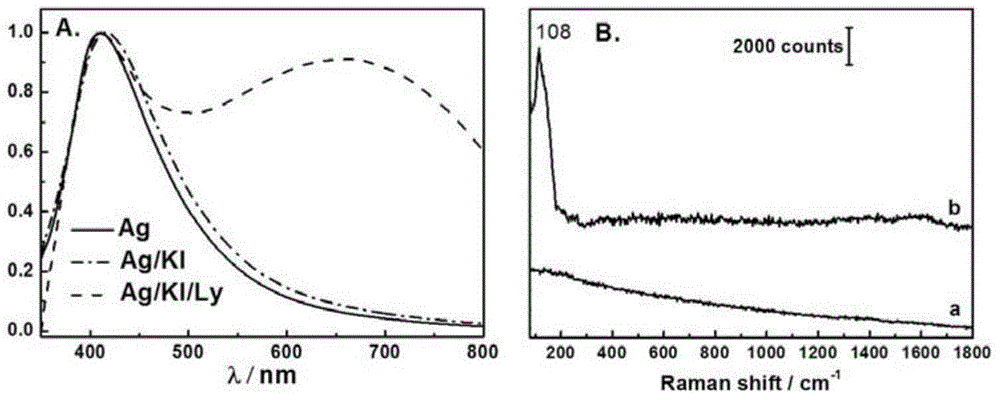Method for enhancing Raman spectroscopy by anion modified nanoparticles
A nanoparticle and Raman spectroscopy technology, which is applied in the field of anion-modified nanoparticle-enhanced Raman spectroscopy, can solve problems such as interference, and achieve the effects of improved sensitivity, simple and easy-to-obtain preparation methods and raw materials, and broadened application range
- Summary
- Abstract
- Description
- Claims
- Application Information
AI Technical Summary
Problems solved by technology
Method used
Image
Examples
Embodiment 1
[0038] A preparation of anion-modified nanoparticles:
[0039] figure 1 A schematic diagram of the experimental procedure for preparing anion-modified nanoparticles is given.
[0040] Taking iodide ion modified silver nanoparticles as an example, the specific preparation method is:
[0041] Take 200mL silver nitrate solution with a concentration of 1mM, heat it to boiling under stirring conditions, then add 6mL aqueous solution of sodium citrate with a mass fraction of 1%, and keep boiling slightly for 1h, the solution finally turns yellow-green. Cool naturally to room temperature to obtain a silver nanoparticle sol with a diameter of about 50 nm. Take 4.5mL silver nanoparticle sol, centrifuge at room temperature (5000r / min, 10min), remove the supernatant, and concentrate the nanoparticle sol to about 50μL. Add 50 μL of 1 mM KI, mix well, and let stand at 25°C for 20 minutes to allow iodide ions to adsorb on the surface of silver nanoparticles in a monolayer to obtain iodid...
Embodiment 2
[0045] Check whether the anion is full of monolayer modification, and compare the effect of nanoparticles with different modification degrees for protein SERS detection:
[0046] Take 1.5mL of silver nanoparticle sol, centrifuge at room temperature (5000r / min, 10min), remove the supernatant, then add ultrapure water to make the volume of nanoparticle sol to 1.5mL, and detect the zeta potential value of the sol. Continuously add 5 μL of 1 mM KI solution to the sol, equilibrate at 25° C. for 10 min after each addition, and then detect the zeta potential value of the sol. Each sample point was measured 5 times continuously and the average value was taken.
[0047] Take 4.5mL silver nanoparticle sol, centrifuge at room temperature (5000r / min, 10min), remove the supernatant, and concentrate the nanoparticle sol to about 50μL. Add 50 μL of KI solutions of different concentrations, mix well, let stand at 25°C for 20 minutes, then fully mix with 50 μL of 1 mg / mL lysozyme protein solu...
Embodiment 3
[0051] Using the method of anion-modified nanoparticles to enhance Raman spectroscopy to study protein molecules, taking lysozyme as an example, comparing the conventional Raman of lysozyme molecules, SERS on anion-modified nanoparticles and SERS on unmodified nanoparticles:
[0052] Iodide ion-modified silver nanoparticles and unmodified silver nanoparticles were synthesized, mixed with 50 μL of 1 mg / mL lysozyme protein solution, and transferred to a 96-well plate for surface-enhanced Raman testing. Another appropriate amount of 100 mg / mL lysozyme solution was taken in a 96-well plate for conventional Raman testing.
[0053] Figure 4 It is the experimental result of embodiment 3. Figure 4 The middle curve a represents the conventional Raman spectrum of lysozyme solution, and curve b represents the SERS spectrum of lysozyme on iodide ion-modified silver nanoparticles. Comparing a and b, it can be found that the SERS spectrum of lysozyme on anion-modified nanoparticles The ...
PUM
| Property | Measurement | Unit |
|---|---|---|
| particle diameter | aaaaa | aaaaa |
| thickness | aaaaa | aaaaa |
| thickness | aaaaa | aaaaa |
Abstract
Description
Claims
Application Information
 Login to View More
Login to View More - R&D
- Intellectual Property
- Life Sciences
- Materials
- Tech Scout
- Unparalleled Data Quality
- Higher Quality Content
- 60% Fewer Hallucinations
Browse by: Latest US Patents, China's latest patents, Technical Efficacy Thesaurus, Application Domain, Technology Topic, Popular Technical Reports.
© 2025 PatSnap. All rights reserved.Legal|Privacy policy|Modern Slavery Act Transparency Statement|Sitemap|About US| Contact US: help@patsnap.com



